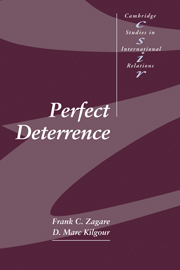1 - Deterrence models
Published online by Cambridge University Press: 01 October 2009
Summary
Four deterrence models are developed in the text and analyzed in appendices 3–8. The purpose of this appendix is to collect information about these models for easy reference and comparison. Appendix 2 collects the definitions and basic properties of quantities used in the analyses. The four deterrence models are listed in table A1.1.
As suggested in table A1.1, several versions of the Asymmetric Escalation Game are considered. The complete-information version of this game is discussed in chapter 6. Before the general incomplete-information model is analyzed in appendix 8 and discussed in chapter 9, two special cases are addressed: the “Massive Retaliation” version, introduced in chapter 7 and analyzed in appendix 6, and the “Flexible Response” version, introduced in chapter 8 and analyzed in appendix 7.
The four deterrence models of table A1.1 have many common features. All are discrete game models with two players, who are called A and B, or Challenger (abbreviated Ch) and Defender (abbreviated Def). Each model has only a few outcomes, including one called Status Quo (SQ). In the first three models, there is one outcome, DD, representing Conflict. In these models, strategies are denoted C and D; generally, C strategies represent acceptance of the Status Quo (or willingness to accept it), and D strategies represent willingness (or threats) to fight to overturn the Status Quo.
- Type
- Chapter
- Information
- Perfect Deterrence , pp. 311 - 322Publisher: Cambridge University PressPrint publication year: 2000



